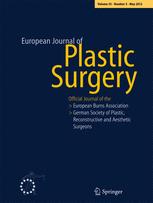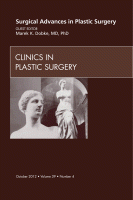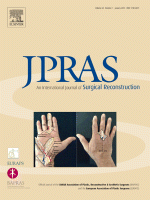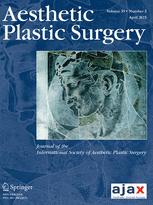Goffart, Y; Karelle, S; Daele, J.
European Journal of Plastic Surgery, October 2015, Volume 38, Issue 5, pp 355-362
 Spreader grafts (SPG) are widely used for different purposes in rhinoplasty procedures. However, selection of the size of the grafts, trimming and fixation often proved time consuming and difficult. We used an original method of placement of “free” SPG to improve both ease of placement and fine trimming of the grafts. To assess pertinence of this approach, we evaluated retrospectively our rate of correction of the middle third of the nose.
Spreader grafts (SPG) are widely used for different purposes in rhinoplasty procedures. However, selection of the size of the grafts, trimming and fixation often proved time consuming and difficult. We used an original method of placement of “free” SPG to improve both ease of placement and fine trimming of the grafts. To assess pertinence of this approach, we evaluated retrospectively our rate of correction of the middle third of the nose.
 Invasive and noninvasive plastic surgical procedures have undergone exponential growth over the last 30 years, due in part to an expansion of extensive basic and clinical research. The purpose of this article is to examine how plastic surgeons learn to use novel technology in their practices. In addition, a critical evaluation of current teaching methods as they relate to surgeon competence in these new technologies is discussed. Mention of specific technologies is done for demonstrative purposes to illustrate how practitioners of plastic surgery gain competence in their safe and effective use.
Invasive and noninvasive plastic surgical procedures have undergone exponential growth over the last 30 years, due in part to an expansion of extensive basic and clinical research. The purpose of this article is to examine how plastic surgeons learn to use novel technology in their practices. In addition, a critical evaluation of current teaching methods as they relate to surgeon competence in these new technologies is discussed. Mention of specific technologies is done for demonstrative purposes to illustrate how practitioners of plastic surgery gain competence in their safe and effective use.
 Rhinoplasty is considered one of the most commonly performed and most challenging operations in facial plastic surgery. The modern facial plastic surgeon utilizes many instruments in performing this procedure. Many of these instruments take their names from the pioneers who invented or designed them. Although meritorious, the recent trend in medicine to move away from eponyms in lieu of descriptive names should not come at the price of forgetting history. Although this communication does not seek to provide a comprehensive history of rhinoplasty or of its pioneers, our aim is to mention several of the salient contributing figures upon whose shoulders we stand and whose eponymous instruments we use commonly in rhinoplasty.
Rhinoplasty is considered one of the most commonly performed and most challenging operations in facial plastic surgery. The modern facial plastic surgeon utilizes many instruments in performing this procedure. Many of these instruments take their names from the pioneers who invented or designed them. Although meritorious, the recent trend in medicine to move away from eponyms in lieu of descriptive names should not come at the price of forgetting history. Although this communication does not seek to provide a comprehensive history of rhinoplasty or of its pioneers, our aim is to mention several of the salient contributing figures upon whose shoulders we stand and whose eponymous instruments we use commonly in rhinoplasty. Various techniques are used in rhinoplasty. These techniques can be classified under transcolumellar approaches and endonasal procedures. Open rhinoplasty without transcolumellar incision (ORWTI) procedure can be described as a combination of these two techniques.
Various techniques are used in rhinoplasty. These techniques can be classified under transcolumellar approaches and endonasal procedures. Open rhinoplasty without transcolumellar incision (ORWTI) procedure can be described as a combination of these two techniques. La ritidoplastia ha pasado por incontables cambios técnicos en relación a los colgajos cutáneos o a los musculares involucrados en el procedimiento. El objetivo de este artículo es demostrar la eficacia de la sutura simple del sistema SMAS-Platisma y la importancia de considerar una filosofía de la naturalidad que será la base de una técnica moderna de ritidoplastia.
La ritidoplastia ha pasado por incontables cambios técnicos en relación a los colgajos cutáneos o a los musculares involucrados en el procedimiento. El objetivo de este artículo es demostrar la eficacia de la sutura simple del sistema SMAS-Platisma y la importancia de considerar una filosofía de la naturalidad que será la base de una técnica moderna de ritidoplastia.





 Sitio web publicado el
Sitio web publicado el
Los lectores comentan